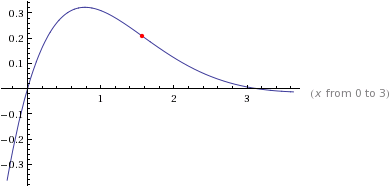Science:Math Exam Resources/Courses/MATH110/April 2013/Question 03 (e)
{{#incat:MER QGQ flag|{{#incat:MER QGH flag|{{#incat:MER QGS flag|}}}}}}
• Q1 (a) • Q1 (b) • Q1 (c) • Q1 (d) • Q2 (a) • Q2 (b) • Q2 (c) • Q2 (d) • Q3 (a) • Q3 (b) • Q3 (c) • Q3 (d) • Q3 (e) • Q4 • Q5 • Q6 • Q7 • Q8 • Q9 (a) • Q9 (b) •
Question 03 (e) |
|---|
|
Let on the interval . In this question you will sketch this function. (e) Make a large sketch of the graph of ƒ below, including all you have found in the previous parts of the question. |
|
Make sure you understand the problem fully: What is the question asking you to do? Are there specific conditions or constraints that you should take note of? How will you know if your answer is correct from your work only? Can you rephrase the question in your own words in a way that makes sense to you? |
|
If you are stuck, check the hint below. Consider it for a while. Does it give you a new idea on how to approach the problem? If so, try it! |
Hint |
|---|
|
Try incorporating the answers from parts a - d in order: first draw the x-intercepts, then where the graph increases and decreases, and finally adding the concavity. |
|
Checking a solution serves two purposes: helping you if, after having used the hint, you still are stuck on the problem; or if you have solved the problem and would like to check your work.
|
Solution |
|---|
|
The function's value is zero at each end of the interval [0,π], we have found a maximum at π/4 and an inflection point at π/2 so your sketch should look something like the plotted function here. Make sure you visibly identify the maximum and inflection point on your sketch of the function. |
{{#incat:MER CT flag||
}}

![{\displaystyle [0,\pi ]}](https://wiki.ubc.ca/api/rest_v1/media/math/render/svg/3e2a912eda6ef1afe46a81b518fe9da64a832751)

